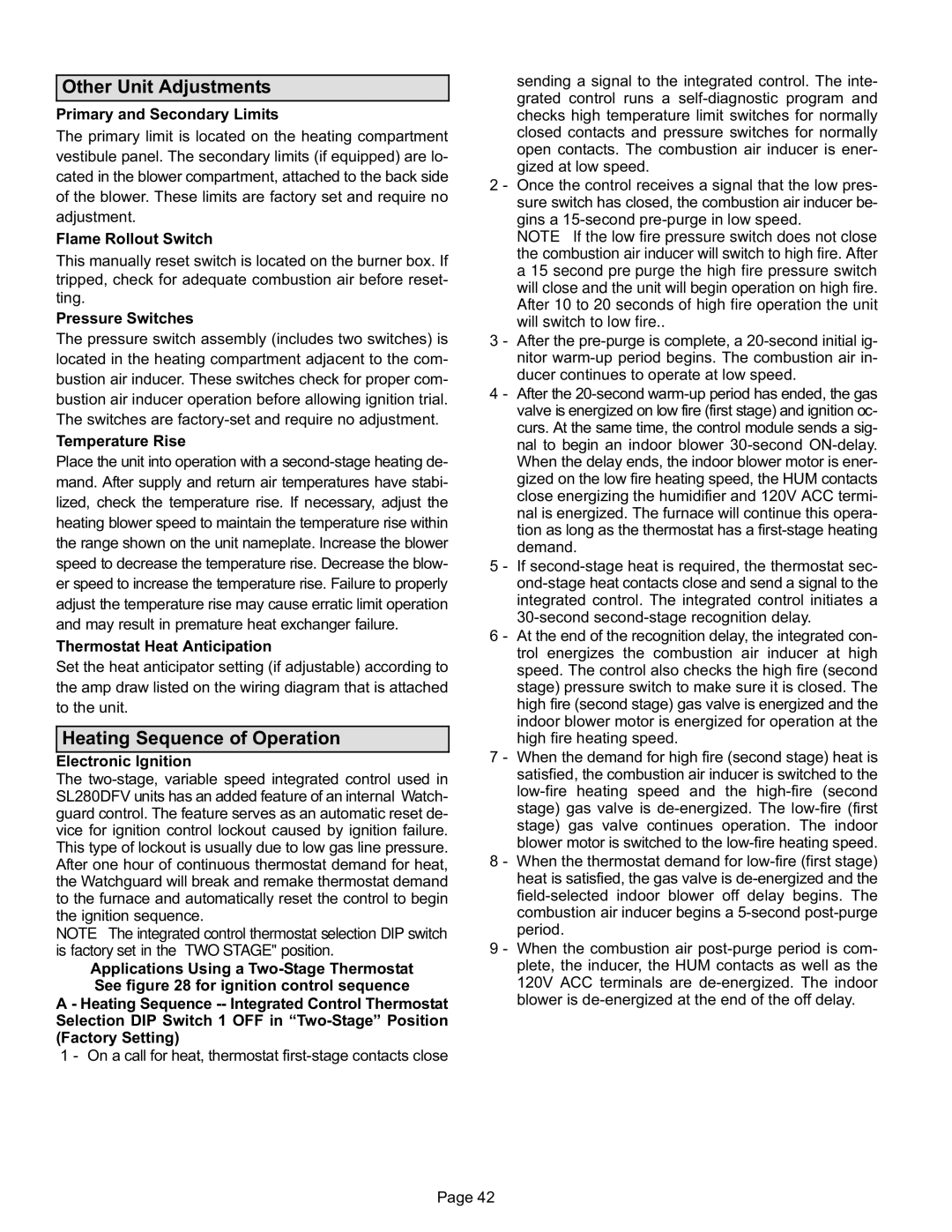Other Unit Adjustments
Primary and Secondary Limits
The primary limit is located on the heating compartment vestibule panel. The secondary limits (if equipped) are lo- cated in the blower compartment, attached to the back side of the blower. These limits are factory set and require no adjustment.
Flame Rollout Switch
This manually reset switch is located on the burner box. If tripped, check for adequate combustion air before reset- ting.
Pressure Switches
The pressure switch assembly (includes two switches) is located in the heating compartment adjacent to the com- bustion air inducer. These switches check for proper com- bustion air inducer operation before allowing ignition trial. The switches are factory−set and require no adjustment.
Temperature Rise
Place the unit into operation with a second−stage heating de- mand. After supply and return air temperatures have stabi- lized, check the temperature rise. If necessary, adjust the heating blower speed to maintain the temperature rise within the range shown on the unit nameplate. Increase the blower speed to decrease the temperature rise. Decrease the blow- er speed to increase the temperature rise. Failure to properly adjust the temperature rise may cause erratic limit operation and may result in premature heat exchanger failure.
Thermostat Heat Anticipation
Set the heat anticipator setting (if adjustable) according to the amp draw listed on the wiring diagram that is attached to the unit.
Heating Sequence of Operation
Electronic Ignition
The two−stage, variable speed integrated control used in SL280DFV units has an added feature of an internal Watch- guard control. The feature serves as an automatic reset de- vice for ignition control lockout caused by ignition failure. This type of lockout is usually due to low gas line pressure. After one hour of continuous thermostat demand for heat, the Watchguard will break and remake thermostat demand to the furnace and automatically reset the control to begin the ignition sequence.
NOTE − The integrated control thermostat selection DIP switch is factory−set in the AGE" position.
Applications Using a Two−Stage Thermostat See figure 28 for ignition control sequence
A − Heating Sequence −− Integrated Control Thermostat Selection DIP Switch 1 OFF in wo−Stage" Position (Factory Setting)
1 − On a call for heat, thermostat first−stage contacts close
sending a signal to the integrated control. The inte- grated control runs a self-diagnostic program and checks high temperature limit switches for normally closed contacts and pressure switches for normally open contacts. The combustion air inducer is ener- gized at low speed.
2 − Once the control receives a signal that the low pres- sure switch has closed, the combustion air inducer be- gins a 15−second pre−purge in low speed.
NOTE − If the low fire pressure switch does not close the combustion air inducer will switch to high fire. After a 15 second pre−purge the high fire pressure switch will close and the unit will begin operation on high fire. After 10 to 20 seconds of high fire operation the unit will switch to low fire..
3 − After the pre−purge is complete, a 20−second initial ig- nitor warm−up period begins. The combustion air in- ducer continues to operate at low speed.
4 − After the 20−second warm−up period has ended, the gas valve is energized on low fire (first stage) and ignition oc- curs. At the same time, the control module sends a sig- nal to begin an indoor blower 30−second ON−delay. When the delay ends, the indoor blower motor is ener- gized on the low fire heating speed, the HUM contacts close energizing the humidifier and 120V ACC termi- nal is energized. The furnace will continue this opera- tion as long as the thermostat has a first−stage heating demand.
5 − If second−stage heat is required, the thermostat sec- ond−stage heat contacts close and send a signal to the integrated control. The integrated control initiates a 30−second second−stage recognition delay.
6 − At the end of the recognition delay, the integrated con- trol energizes the combustion air inducer at high speed. The control also checks the high fire (second stage) pressure switch to make sure it is closed. The high fire (second stage) gas valve is energized and the indoor blower motor is energized for operation at the high fire heating speed.
7 − When the demand for high fire (second stage) heat is satisfied, the combustion air inducer is switched to the low−fire heating speed and the high−fire (second stage) gas valve is de−energized. The low−fire (first stage) gas valve continues operation. The indoor blower motor is switched to the low−fire heating speed.
8 − When the thermostat demand for low−fire (first stage) heat is satisfied, the gas valve is de−energized and the field−selected indoor blower off delay begins. The combustion air inducer begins a 5−second post−purge period.
9 − When the combustion air post−purge period is com- plete, the inducer, the HUM contacts as well as the 120V ACC terminals are de−energized. The indoor blower is de−energized at the end of the off delay.

